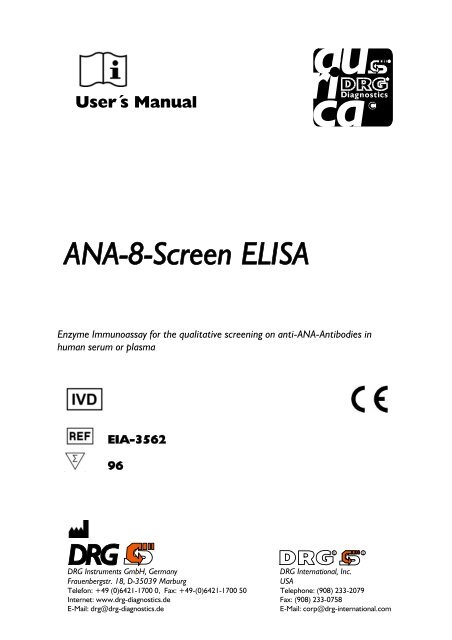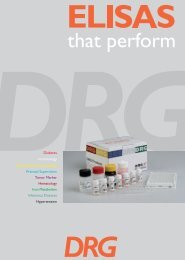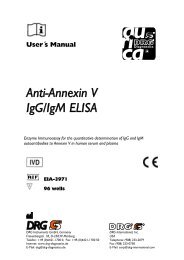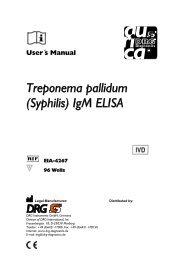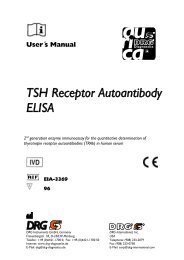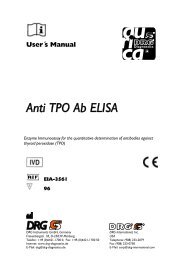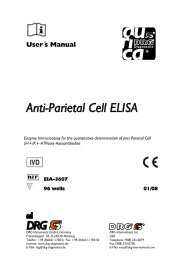ANA-8-Screen ELISA - DRG Diagnostics GmbH
ANA-8-Screen ELISA - DRG Diagnostics GmbH
ANA-8-Screen ELISA - DRG Diagnostics GmbH
Create successful ePaper yourself
Turn your PDF publications into a flip-book with our unique Google optimized e-Paper software.
User´s Manual<br />
<strong>ANA</strong>-8-<strong>Screen</strong> <strong>ELISA</strong><br />
Enzyme Immunoassay for the qualitative screening on anti-<strong>ANA</strong>-Antibodies in<br />
human serum or plasma<br />
EIA-3562<br />
96<br />
<strong>DRG</strong> Instruments <strong>GmbH</strong>, Germany <strong>DRG</strong> International, Inc.<br />
Frauenbergstr. 18, D-35039 Marburg USA<br />
Telefon: +49 (0)6421-1700 0, Fax: +49-(0)6421-1700 50 Telephone: (908) 233-2079<br />
Internet: www.drg-diagnostics.de Fax: (908) 233-0758<br />
E-Mail: drg@drg-diagnostics.de E-Mail: corp@drg-international.com
<strong>ANA</strong>-8-<strong>Screen</strong> <strong>ELISA</strong> EIA-3562<br />
Version 3.0<br />
Effective, September 2010 (e-2009-08_05)<br />
(it 0803-03)<br />
Please use only the valid version of the package insert provided with the kit.<br />
Verwenden Sie nur die jeweils gültige, im Testkit enthaltene, Arbeitsanleitung.<br />
Si prega di usare la versione valida dell'inserto del pacco a disposizione con il kit.<br />
Por favor, se usa solo la version valida de la metodico técnico incluido aqui en el kit.<br />
Table of Contents / Inhaltsverzeichnis / Tabella die Contenuti / Tabla de Contenidos<br />
1 NAME AND INTENDED USE ................................................................................................................... 2<br />
2 SUMMARY AND EXPL<strong>ANA</strong>TION OF THE TEST .................................................................................... 2<br />
3 PRINCIPLE OF THE TEST....................................................................................................................... 2<br />
4 WARNINGS AND PRECAUTIONS........................................................................................................... 2<br />
5 CONTENTS OF THE KIT ......................................................................................................................... 3<br />
6 STORAGE AND STABILITY..................................................................................................................... 3<br />
7 MATERIALS REQUIRED.......................................................................................................................... 4<br />
8 SPECIMEN COLLECTION, STORAGE AND HANDLING ....................................................................... 4<br />
9 PROCEDURAL NOTES............................................................................................................................ 4<br />
10 PREPARATION OF REAGENTS ............................................................................................................. 5<br />
11 TEST PROCEDURE................................................................................................................................. 5<br />
12 INTERPRETATION OF RESULTS........................................................................................................... 6<br />
13 PERFORMANCE CHARACTERISTICS................................................................................................... 7<br />
14 LIMITATIONS OF PROCEDURE ............................................................................................................. 7<br />
15 INTERFERING SUBSTANCES ................................................................................................................ 7<br />
16 REFERENCES / LITERATURE................................................................................................................ 8<br />
1 CONTENUTO DEL KIT............................................................................................................................. 9<br />
2 AVVERTENZEE PRECAUZZIONI............................................................................................................ 9<br />
3 CONSERVAZIONE E STABILITÁ .......................................................................................................... 10<br />
4 MATERIALE NECESSARIO ................................................................................................................... 10<br />
5 RACCOLTA, CONSERVAZIONE, MANIPOLAZIONE DEI CAMPIONI ................................................. 10<br />
6 AVVERTENZE OPERATIVE .................................................................................................................. 11<br />
7 PREPARAZIONE DEI REAGENTI ......................................................................................................... 11<br />
8 ESECUZIONE DEL TEST ...................................................................................................................... 12<br />
9 INTERPRETAZIONE DEI RISULTATI.................................................................................................... 12<br />
SYMBOLS USED WITH <strong>DRG</strong> ASSAYS.......................................................................................................... 13<br />
Version 3.0; 2010/09 - vk - 1 -
<strong>ANA</strong>-8-<strong>Screen</strong> <strong>ELISA</strong> EIA-3562<br />
1 NAME AND INTENDED USE<br />
The <strong>ANA</strong>-8-<strong>Screen</strong> assay is a qualitative enzyme immunoassay (EIA) intended to screen for the presence of<br />
antinuclear antibodies (<strong>ANA</strong>s) in human serum or plasma as an aid in the diagnosis of certain systemic<br />
rheumatic diseases. This assay collectively detects, in one well, <strong>ANA</strong>s against SS-A/Ro, SS-B/La, RNP 70, Sm,<br />
RNP/Sm, Centromere B and Jo-1.<br />
2 SUMMARY AND EXPL<strong>ANA</strong>TION OF THE TEST<br />
Inflammatory connective tissue diseases are characterized by idiopathic genesis along with disturbances in<br />
terms of cellular and humoral immunity, systemic organ failure and a chronic course of disease. Additionally,<br />
connective tissue diseases exhibit overlapping symptomatic features that render an accurate diagnosis<br />
difficult [1].<br />
Considering the diversity of mixed connective tissue diseases, such disorders exhibit a common serological<br />
characteristic: the presence of anti-nuclear antibodies [2]. These antibodies are directed against parts of the cell<br />
nucleus and the cytoplasm, and many rheumatic diseases are characterized by the presence of one or more of<br />
these <strong>ANA</strong>s [3].<br />
Antibodies to double-stranded DNA (dsDNA), single-stranded DNA (ssDNA), histone, nuclear ribonucleoprotein<br />
(RNP) and Smith antigen (Sm) are associated with SLE [4], while antibodies to Sjögren´s syndrome A<br />
(SS-A/Ro) and Sjögren´s syndrome B (SS-B/La) can occur in both SLE and Sjögren´s syndrome (SS) [5, 6].<br />
Antibodies to Jo-1 may be observed in polymyositis and dermatomyositis [6], while antibodies to sclerodermaassociated<br />
antigen (Scl-70) and centromere can occur in patients with progressive systemic sclerosis (PSS).<br />
Anti-histone antibodies are associated with SLE and drug-induced lupus [7], while anti-RNP antibodies are<br />
linked with mixed connective tissue disease (MCTD) and with SLE [2]. Antibodies directed against centromere<br />
are associated with CREST syndrome [3].<br />
Although IFA technology was traditionally used to detect autoantibodies in conjunction with HEp2 cells, it is now<br />
widely acknowledged that <strong>ELISA</strong> technology offers an excellent alternative. IFA technology is subject to errors<br />
of interpretation and can be labor-intensive when applied to a large number of unknown samples [8].<br />
The <strong>ANA</strong>-8 <strong>Screen</strong> <strong>ELISA</strong> assay allows for collective and simultaneous screening for the autoantibodies of<br />
major significance in one microwell, and effectively eliminates the need for individual interpretation that is<br />
inherent in IFA technology.<br />
3 PRINCIPLE OF THE TEST<br />
Purified antigens (SS-A/Ro, SS-B/La, RNP 70, Sm, RNP/Sm, Scl-70, centromere B and Jo-1) are bound to<br />
microwells. Antibodies against these antigens, if present in diluted serum or plasma, bind to the respective<br />
antigen. Washing of the microwells removes unspecific serum and plasma components. Horseradish<br />
peroxidase (HRP) conjugated anti-human IgG immunologically detects the bound patient antibodies forming a<br />
conjugate/antibody/antigen complex. Washing of the microwells removes unbound conjugate. An enzyme<br />
substrate in the presence of bound conjugate hydrolyzes to form a blue colour. The addition of an acid stops the<br />
reaction forming a yellow end-product.<br />
The intensity of this yellow colour is measured photometrically at 450 nm.<br />
4 WARNINGS AND PRECAUTIONS<br />
1. All reagents of this kit are strictly intended for in vitro diagnostic use only.<br />
2. Do not interchange kit components from different lots.<br />
3. Components containing human serum were tested and found negative for HBsAg, HCV, HIV1 and HIV2 by<br />
FDA approved methods. No test can guarantee the absence of HBsAg, HCV, HIV1 or HIV2, and so all<br />
human serum based reagents in this kit must be handled as though capable of transmitting infection.<br />
4. Avoid contact with the TMB (3,3´,5,5´-Tetramethyl-benzidine). If TMB comes into contact with skin, wash<br />
thoroughly with water and soap.<br />
5. Avoid contact with the Stop Solution which is acid. If it comes into contact with skin, wash thoroughly with<br />
water and seek medical attention.<br />
Version 3.0; 2010/09 - vk - 2 -
<strong>ANA</strong>-8-<strong>Screen</strong> <strong>ELISA</strong> EIA-3562<br />
6. Some kit components (i.e. Controls, Sample buffer and Buffered Wash Solution) contain Sodium Azide as<br />
preservative. Sodium Azide (NaN3) is highly toxic and reactive in pure form. At the product concentrations<br />
(0.09%), though not hazardous. Despite the classification as nonhazardous, we strongly recommend using<br />
prudent laboratory practices (see 8., 9., 10.).<br />
7. Some kit components contain Proclin 300 as preservative. When disposing reagents containing<br />
Proclin 300, flush drains with copious amounts of water to dilute the components below active levels.<br />
8. Wear disposable gloves while handling specimens or kit reagents and wash hands thoroughly afterwards.<br />
9. Do not pipette by mouth.<br />
10. Do not eat, drink, smoke or apply makeup in areas where specimens or kit reagents are handled.<br />
11. Avoid contact between the buffered Peroxide Solution and easily oxidized materials; extreme temperature<br />
may initiate spontaneous combustion.<br />
Observe the guidelines for performing quality control in medical laboratories by assaying controls and/or pooled<br />
sera. During handling of all kit reagents, controls and serum samples observe the existing legal regulations.<br />
5 CONTENTS OF THE KIT<br />
Package size 96 determ.<br />
Qty.1 Divisible <strong>ANA</strong> microtiter strips: 96 antigen-coated wells sealed in a foil pouch with<br />
desiccant. Ready to use.<br />
2 vials, 1.5 ml each Anti-<strong>ANA</strong> controls in a serum/buffer matrix (PBS, NaN3
<strong>ANA</strong>-8-<strong>Screen</strong> <strong>ELISA</strong> EIA-3562<br />
7 MATERIALS REQUIRED<br />
Equipment<br />
- Microplate reader capable of endpoint measurements at 450 nm<br />
- Multi-Channel Dispenser or repeatable pipet for 100 µl<br />
- Vortex mixer<br />
- Pipets for 10 µl, 100 µl and 1000 µl<br />
- Laboratory timing device<br />
- Data reduction software<br />
Preparation of reagents<br />
- Distilled or deionized water<br />
- Graduated cylinder for 100 and 1000 ml<br />
- Plastic container for storage of the wash solution<br />
8 SPECIMEN COLLECTION, STORAGE AND HANDLING<br />
1. Collect whole blood specimens using acceptable medical techniques to avoid hemolysis.<br />
2. Allow blood to clot and separate the serum by centrifugation.<br />
3. Test serum should be clear and non-hemolysed. Contamination by hemolysis or lipemia is best avoided,<br />
but does not interfere with this assay.<br />
4. Specimens may be refrigerated at 2-8 °C for up to five days or stored at -20 °C up to six months.<br />
5. Avoid repetitive freezing and thawing of serum samples. This may result in variable loss of autoantibody<br />
activity.<br />
6. Testing of heat-inactivated sera is not recommended.<br />
9 PROCEDURAL NOTES<br />
1. Do not use kit components beyond their expiration dates.<br />
2. Do not interchange kit components from different lots.<br />
3. All materials must be at room temperature (20-28 °C).<br />
4. Have all reagents and samples ready before start of the assay. Once started, the test must be performed<br />
without interruption to get the most reliable and consistent results.<br />
5. Perform the assay steps only in the order indicated.<br />
6. Always use fresh sample dilutions.<br />
7. Pipette all reagents and samples into the bottom of the wells.<br />
8. To avoid carryover contamination, change the tip between samples and different kit controls.<br />
9. It is important to wash microwells thoroughly and remove the last droplets of wash buffer to achieve best<br />
results.<br />
10. All incubation steps must be accurately timed.<br />
11. Control sera or pools should routinely be assayed as unknowns to check performance of the reagents and<br />
the assay.<br />
12. Do not re-use microplate wells.<br />
For all controls, the respective concentrations are provided on the labels of each vial. Using these<br />
concentrations a calibration curve may be calculated to read off the patient results semi-quantitatively.<br />
Version 3.0; 2010/09 - vk - 4 -
10 PREPARATION OF REAGENTS<br />
<strong>ANA</strong>-8-<strong>Screen</strong> <strong>ELISA</strong> EIA-3562<br />
10.1 Preparation of sample buffer<br />
Dilute the contents of each vial of the sample buffer concentrate (5x) with distilled or deionized water to a final<br />
volume of 100 ml prior to use.<br />
Store refrigerated: stable at 2-8°C for at least 30 days after preparation or until the expiration date printed on the<br />
label.<br />
10.2 Preparation of wash solution<br />
Dilute the contents of each vial of the buffered wash solution concentrate (50x) with distilled or deionized water<br />
to a final volume of 1000 ml prior to use.<br />
Store refrigerated: stable at 2-8°C for at least 30 days after preparation or until the expiration date printed on the<br />
label.<br />
10.3 Sample preparation<br />
Dilute all patient samples 1:100 with sample buffer before assay.<br />
Therefore combine 10 µl of sample with 990 µl of sample buffer in a polystyrene tube. Mix well.<br />
Controls are ready to use and need not be diluted.<br />
11 TEST PROCEDURE<br />
1. Prepare a sufficient number of microplate modules to accommodate controls and prediluted patient<br />
samples.<br />
2. Pipet 100 µl of calibrators, controls and prediluted patient samples in duplicate into the wells.<br />
1 2 3 4 5 6<br />
A CC P..<br />
B NC P..<br />
C P1<br />
D P2 P1, P2... patient samples 1, 2 ...<br />
E P3 CC: calibrator control<br />
F P4 NC: negative control<br />
G P5<br />
H P6<br />
3. Incubate for 30 minutes at room temperature (20-28°C)<br />
4. Discard the contents of the microwells and wash 3 times with 300 µl of wash solution.<br />
5. Dispense 100 µl of enzyme conjugate into each well<br />
6. Incubate for 15 minutes at room temperature<br />
7. Discard the contents of the microwells and wash 3 times with 300 µl of wash solution<br />
8. Dispense 100 µl of TMB substrate solution into each well<br />
9. Incubate for 15 minutes at room temperature<br />
10. Add 100 µl of stop solution to each well of the modules and incubate for 5 minutes at room temperature<br />
11. Read the optical density at 450 nm and calculate the results. Bi-chromatic measurement with a reference at<br />
600-690 nm is recommended.<br />
The developed colour is stable for at least 30 minutes. Read optical densities during this time.<br />
Version 3.0; 2010/09 - vk - 5 -
12 INTERPRETATION OF RESULTS<br />
<strong>ANA</strong>-8-<strong>Screen</strong> <strong>ELISA</strong> EIA-3562<br />
12.1 Quality Control<br />
This test is only valid if the optical density at 450 nm for Negative Control (NC) and Calibrator Control (CC)<br />
complies with the respective range indicated on the Quality Control Certificate enclosed to each test kit! If any of<br />
these criteria is not fulfilled, the results are invalid and the test should be repeated.<br />
The assays is calibrated against the internationally recognised reference sera from CDC, Atlanta, USA and<br />
furthermore against the WHO reference preparation for human anti-dsDNA Wo/80.<br />
12.2 Calculation of results<br />
Evaluation of the <strong>ANA</strong>-8 <strong>Screen</strong> test is carried out by a comparison of the optical density of each patient sample<br />
with the optical density of the cut-off. The cut-off needs to be calculated first, by multiplying the OD of the<br />
calibrator control by the test specific factor 0.5.<br />
ODCut off = ODCalibrator Control x 0.5<br />
For detailed semi-quantification of the results, each patient-OD value can be expressed by the "Index Value".<br />
The Index Value is calculated by dividing the sample-OD by the calculated cut-off-OD.<br />
Index Value = ODSample / ODCut off<br />
12.3 Interpretation of results<br />
<strong>ANA</strong> screen (Index Value)<br />
Negative: < 1.0<br />
Borderline: 1.0 - 1.2<br />
Positive: ≥ 1.2<br />
Patient samples exhibiting optical densities higher than the optical density of the calculated cut-off Control are<br />
considered to be positive.<br />
Negative: OD Patient < OD Cut-Off<br />
Positive: OD Patient > OD Cut-Off<br />
The calculation of Index Values is not influenced by variations of the sample-OD and/or cut-off-OD.<br />
Index Values are recommended for long term validations (i.e. internal quality control samples).<br />
Due to additive effects of each of the coated antigens, sera with positive results in the <strong>ANA</strong>-8-<strong>Screen</strong> <strong>ELISA</strong> test<br />
may be determined as negative upon confirmatory testing.<br />
All positive screen results should be confirmed using assays such as the <strong>ANA</strong> combi test or the individual<br />
quantitative <strong>ANA</strong> test.<br />
The table shows typical results for <strong>ANA</strong>-8-<strong>Screen</strong>. These data are intended for illustration only and should not<br />
be used to calculate results from another run.<br />
Sample No. Sample OD OD Cut-Off Index Value Interpretation<br />
1 0.107 0.535 0.20 negative<br />
2 0.535 0.535 1.00 borderline<br />
3 1.294 0.535 2.42 positive<br />
4 2.496 0.535 4.67 positive<br />
Version 3.0; 2010/09 - vk - 6 -
<strong>ANA</strong>-8-<strong>Screen</strong> <strong>ELISA</strong> EIA-3562<br />
12.4 Expected Values<br />
The approximate incidence of positive <strong>ANA</strong> is 5% in the general normal population, 40% in normal old age and<br />
25% in healthy relatives of SLE patients. <strong>ANA</strong> positivity has been reported in:<br />
SLE (systemic Lupus erythemotosus) > 95 %<br />
SS (Sjogren´s sysndrome) 50 – 65 %<br />
PSS (progressive systemic sklerosis) 40 – 60 %<br />
RA (rheumatoid arthritis) 12 – 24 %<br />
juvenile RA (juvenile rheumatoid arthritis) 20 %<br />
13 PERFORMANCE CHARACTERISTICS<br />
13.1 Specificity<br />
The microplate is coated with a mixture of the antigens SS-A (Ro), SS-B (La), Sm, RNP-70 Kd, RNP/Sm,<br />
Scl-70, Centromere B and Jo-1, highly purified by affinity chromatography.<br />
The <strong>ANA</strong>8 screen test is specific only for autoantibodies directed to these antigens. No cross reactivities have<br />
been observed.<br />
13.2 Calibration<br />
The assay system is calibrated against the internationally recognised reference sera from CDC, Atlanta USA,<br />
since no other international standards are available.<br />
14 LIMITATIONS OF PROCEDURE<br />
1. The <strong>ANA</strong>-8-<strong>Screen</strong> <strong>ELISA</strong> is a diagnostic aid. A definite clinical diagnosis should not be based on the<br />
results of a single test, but should be made by the physician after all clinical and laboratory findings have<br />
been evaluated.<br />
2. Due to the potential for a cumulative effect of each of the coated antigens, sera with positive results in the<br />
<strong>ANA</strong>-8-<strong>Screen</strong> <strong>ELISA</strong> test may be determined to be negative when confirmatory testing is performed.<br />
Positive <strong>ANA</strong> may be found in apparently healthy people.<br />
3. SLE patients undergoing steroid therapy may have negative test results.<br />
4. Commonly prescribed drugs may induce <strong>ANA</strong>.<br />
15 INTERFERING SUBSTANCES<br />
No interference has been observed with haemolytic (up to 1000 mg/dL), lipemic (up to 3 g/dL triglycerides) or<br />
bilirubin (up to 40 mg/dL) containing sera.<br />
Nor have any interfering effects been observed with the use of anticoagulants. However for practical reasons it<br />
is recommended that grossly hemolyzed or lipemic samples be avoided.<br />
Version 3.0; 2010/09 - vk - 7 -
<strong>ANA</strong>-8-<strong>Screen</strong> <strong>ELISA</strong> EIA-3562<br />
16 REFERENCES / LITERATURE<br />
1. Hiepe F., Burmester G.R.. Klinik und Diagnostik des systematischen Lupus erythemadodes.<br />
Dtsch.med.Wschr.; Vol.121; 1129-1133; 1996.<br />
2. Nakamura R.M., Tan E.M.. Update on autoantibodies to intracellular antigens in systemic rheumatic<br />
diseases. Clin.Lab.Med.; Vol.12; 1-23; 1992.<br />
3. Barland P., Lipstein E.. Selection and use of laboratory test in the rheumatic diseases.<br />
Am.J.Med.; Vol.100 (suppl 2A); 16s-23s.<br />
4. Isenberg D.A., Ravirajan C.T., Rahman A., Kalsi J.. The role of antibodies to DNA in systemic lupus<br />
erythematosus - A review and introduction to an international workshop on DNA antibodies held in London,<br />
May 1996. Lupus; 6; 290-304; 1997.<br />
5. Alexander E, Buyon J.P., Provost T.T., Guarnieri T. Anti-Ro/SS-A antibodies in the pathophysiology of<br />
congenital heart block in neonatal lupus syndrome, an experimental model. Arthritis and Rheumatism;<br />
Vol. 35 No.2; 176-189; 1992.<br />
6. Hietarinta M., Lassila O.. Clinical significance of antinuclear antibodies in systemic rheumatic disease.<br />
Ann.Med.; Vol.28; 283-291; 1996.<br />
7. Fritzler M.J.. Clinical relevance of autoantibodies in systemic rheumatic diseases.<br />
Mol.Biol.Rep.; Vol.23; 133-145; 1996.<br />
8. Feltkamp T.E.W.. Antinuclear antibody determination in a routine laboratory.<br />
Ann.Rheum.Dis.; Vol.55; 723-727; 1996.<br />
9. Amoura Z., Koutouzov S., Chabre H., Cacoub P., Amoura I., Musset L., Bach J.-F., Piette J.-C.<br />
Presence of antinucleosome autoantibodies in a restricted set of connective tissue diseases.<br />
Arthritis and Rheumatism; Vol. 43 (1); 76-84; 2000.<br />
10. Lundberg U.N., Hedfors E., Pettersson I.. Recombinant 70-kD protein for determination of autoantigenic<br />
epitopes by anti-RNP sera. Clin.Exp.Immunol.; 81; 52-58; 1990.<br />
11. Sanchez-Guerrero J., Lew R.A., Fossel A.H., Schur P.H.. Utility of anti-Sm, anti-RNP, anti-Ro/SS-A, and<br />
anti-La/SS-B (extractable nuclear antigens) detected by enzyme linked immunosorbent assay for the<br />
diagnosis of systemic lupus erythematodes. Arth.Rheum.; Vol.39; 1055-1061; 1996.<br />
12. Shen G.Q., Shoenfeld Y., Peter J.B.. Anti-DNA, anti-histone and anti-nucleosome antibodies in systemic<br />
Lupus erythematosus and drug-induced Lupus. Clin. Reviews in Allergy and Immunology;<br />
Vol.16; 321-334; 1998.<br />
Version 3.0; 2010/09 - vk - 8 -
<strong>ANA</strong>-8-<strong>Screen</strong> <strong>ELISA</strong> EIA-3562<br />
Test immunometrico per la determinazione qualitativa degli autoanticorpi anti-nucleo (<strong>ANA</strong>) della classe IgG<br />
Per uso diagnostico in vitro esclusivo.<br />
1 CONTENUTO DEL KIT<br />
1 Micropiastra a pozzetti separabili costituita da 12 strip da 8 pozzetti ciascuno,<br />
sensibilizzata con SS-A/Ro, SS-B/La, RNP 70, Sm, RNP/Sm, Scl-70, centromero B<br />
e Jo-1.<br />
Pronta all'uso.<br />
2 flaconi da 1,5 mL cad. <strong>ANA</strong> Controllo negativo (NC) e <strong>ANA</strong> controllo di calibrator (CC) in matrice<br />
serica tamponata (PBS, BSA, Sodio Azide< 0,1% (p/p);<br />
le rispettive concentrazioni sono riportate nel foglietto illustrativo.<br />
Pronti all'uso.<br />
1 flacone da 20 mL Diluente campioni (TRIS, Sodio Azide
<strong>ANA</strong>-8-<strong>Screen</strong> <strong>ELISA</strong> EIA-3562<br />
3 CONSERVAZIONE E STABILITÁ<br />
1. Conservare il kit a 4-8°C<br />
2. Mantenere la micropiastra sigillata in una busta, con essicante, a tenuta di umidità<br />
3. I reagenti sono stabili fino alla scadenza riportata sul kit<br />
4. Mantenere i reagenti al riparo da calore, sole, luce solare diretta durante la conservazione e l'uso<br />
5. Il tampone diluente il campione e il tampone di lavaggio sono stabili almeno 30 gg, se conservati a 2-8°C,<br />
dopo la loro preparazione.<br />
4 MATERIALE NECESSARIO<br />
Strumentazione<br />
− Lettore di micropiastre con possibilità di misurazione end point, a 450 nm<br />
− Dispensatore multicanale o pipetta sequenziale da 100 µl<br />
− Pipette da 10, 100, 1000 µl<br />
− Agitatore di tipo vortex<br />
− Orologio da laboratorio<br />
− Software per l'elaborazione dei dati<br />
Preparazione dei reagenti<br />
− acqua distillata o deionizzata<br />
− cilindri graduati da 100 ml e 1000 mL<br />
− bottiglie di plastica per la conservazione della soluzione di lavaggio<br />
5 RACCOLTA, CONSERVAZIONE, MANIPOLAZIONE DEI CAMPIONI<br />
1. Il prelievo di sangue deve essere eseguito con le modalità necessarie per evitare l'emolisi del campione<br />
2. Attendere che il campione sia coagulato e separare il siero per centrifugazione<br />
3. Verificare che il siero sia non emolizzato. Sebbene emolisi e lipidi non interferiscono nella determinazione,è<br />
opportuno l'uso di campioni non lipemici e non emolizzati.<br />
4. I campioni possono essere conservati a 4-8°C fino a 5 giorni, oppure a -20°C fino a 6 mesi<br />
5. Evitare di congelare e scongelare ripetutamente i campioni di siero. Ciò può causare una perdita di attività<br />
auto anticorpale.<br />
6. Non è raccomandato testare sieri inattivati col calore.<br />
Version 3.0; 2010/09 - vk - 10 -
<strong>ANA</strong>-8-<strong>Screen</strong> <strong>ELISA</strong> EIA-3562<br />
6 AVVERTENZE OPERATIVE<br />
1. Non usare kit scaduti.<br />
2. Non intercambiare componenti di kit con diversi numeri di lotto.<br />
3. Tutti i materiali devono essere conservati a temperatura ambiente.<br />
4. Preparare tutte le soluzioni di lavoro prima di iniziare il ciclo analitico; questo deve essere completato senza<br />
interruzioni al fine di ottenere risultati affidabili e coerenti.<br />
5. Utilizzare la procedura analitica indicata.<br />
6. Usare sempre campioni freschi.<br />
7. Pipettare reagenti e campioni sul fondo del pozzetto.<br />
8. Lavare accuratamente i pozzetti e rimuovere tutte le goccioline di tampone di lavaggio al fine di ottenere i<br />
risultati più corretti.<br />
9. Rispettare accuratamente i tempi di incubazione.<br />
10. Cambiare i puntali dopo la dispensazione di ciascun campione e dei controlli, al fine di evitare fenomeni di<br />
trascinamento.<br />
11. I sieri e i pool serici di controllo vanno trattati come campioni anonimi al fine di valutare le prestazioni dei<br />
reagenti.<br />
12. Non riutilizzare piastre già usate.<br />
Le concentrazioni dei controlli sono riportate sulle rispettive etichette; utilizzando queste concentrazioni è<br />
possibile costruire una curva di taratura ed ottenere dei risultati semiquantitativi.<br />
7 PREPARAZIONE DEI REAGENTI<br />
7.1 Preparazione del Diluente campioni<br />
Prima dell'uso, diluire il contenuto di ciascun flacone di Diluente campioni concentrato 5X con acqua distillata o<br />
deionizzata fino a un volume finale di 100 ml.<br />
Conservare in frigorifero: la stabilità è di almeno 30 gg a 2-8°C dalla data di preparazione, o fino alla data di<br />
scadenza stampata in etichetta.<br />
7.2 Preparazione del Tampone di Lavaggio<br />
Prima dell'uso, diluire il contenuto di ciascun flacone di tampone di lavaggio concentrato 50X con acqua<br />
distillata o demonizzata fino a un volume finale di 1000 ml.<br />
Conservare in frigorifero: la stabilità è di almeno 30 gg a 2-8°C dalla data di preparazione, o fino alla data di<br />
scadenza stampata in etichetta.<br />
7.3 Preparazione dei campioni<br />
Diluire tutti i campioni 1:100 con il Diluente campioni.<br />
Dispensare 10 µl di campione in 990 µl Diluente campioni in una provetta di plastica. Miscelare bene.<br />
I controlli sono pronti per l'uso e non necessitano di diluizioni.<br />
Version 3.0; 2010/09 - vk - 11 -
<strong>ANA</strong>-8-<strong>Screen</strong> <strong>ELISA</strong> EIA-3562<br />
8 ESECUZIONE DEL TEST<br />
1. Prelevare il numero di strip necessario per l'analisi in funzione del numero di campioni, controlli e calibratori<br />
2. Dispensare nei rispettivi pozzetti 100 µl dei calibratori, controlli e campioni prediluiti.<br />
3. Incubare per 30' a temperatura ambiente (20-28°C).<br />
4. Svuotare i pozzetti e lavare 3 volte con 300 µl di soluzione di lavaggio.<br />
5. Dispensare 100 µl di coniugato in ciascun pozzetto.<br />
6. Incubare per 15' a T.A.<br />
7. Svuotare i pozzetti e lavare 3 volte con 300 µl di soluzione di lavaggio.<br />
8. Dispensare 100 µl di TMB in ciascun pozzetto.<br />
9. Incubare per 15' a T.A.<br />
10. Dispensare 100 µl di Soluzione Stoppante a ciascun pozzetto.<br />
11. Leggere la Densità Ottica a 450 nm e calcolare il risultato. E' raccomandata una lettura in bicromatismo con<br />
una lunghezza d'onda di riferimento a 600-690 nm.<br />
Il colore è stabile per almeno 30'. Leggere la Densità Ottica in questo periodo di tempo.<br />
9 INTERPRETAZIONE DEI RISULTATI<br />
9.1 Controllo di Qualità<br />
Il test è valido solo se la D.O. a 450 nm per il controllo negativo (NC) e controllo di calibrator cadono nei limiti<br />
indicati nel Certificato di Controllo di Qualità allegato a ciascun kit. Se tutti questi criteri non sono riscontrati, i<br />
risultati devono essere considerati non validi e il test deve essere ripetuto.<br />
9.2 Calcolo dei risultati<br />
Specific Factor 0,5 sono indicati nel Certificato di Controllo.<br />
ODCut off = ODCalibrator Control x 0.5<br />
Per ottenere dettagliate risposte semiquantitative, il valore di D.O. di ciascun paziente può essere espresso<br />
come "Index Value"; l'Index Value è calcolato dividendo la D.O. di ciascun campione per la D.O. del controllo<br />
Cut-Off. Il calcolo di Index Value non è influenzato da variazioni della D.O. del campione e del controllo di<br />
Cut-Off. Index Value è particolarmente utile per validazioni del reagente a lungo termine (p.e. per i controlli di<br />
qualità interni).<br />
Index Value = ODSample / ODCut off<br />
9.3 Interpretazione dei risultati<br />
1. La interpretazione del test può essere eseguita per diretta correlazione tra la D.O. di ciascun paziente e la<br />
D.O. del controllo di cut-off. Campioni di pazienti con D.O maggiore della D.O del controllo di Cut-off sono<br />
considerati positivi.<br />
Negativo: campione con D.O. < della D.O. del controllo di cut-off<br />
Positivo: campione con D.O. > della D.O. del controllo di cut-off.<br />
2. Index Values sono interpretati come segue:<br />
<strong>ANA</strong> screen <strong>ELISA</strong> (Index Value)<br />
Negativo: < 1.0<br />
Borderline: 1.0 - 1.2<br />
Positivo: ≥ 1.2<br />
Version 3.0; 2010/09 - vk - 12 -
SYMBOLS USED WITH <strong>DRG</strong> ASSAYS<br />
<strong>ANA</strong>-8-<strong>Screen</strong> <strong>ELISA</strong> EIA-3562<br />
Symbol English Deutsch Français Español Italiano<br />
Consult instructions for<br />
use<br />
European Conformity<br />
In vitro diagnostic<br />
device<br />
RUO For research use only<br />
Gebrauchsanweisung<br />
beachten<br />
CE-Konfirmitätskennzeichnung<br />
In-vitro-Diagnostikum<br />
Nur für<br />
Forschungszwecke<br />
Consulter les<br />
instructions d’utilisation<br />
Conformité aux<br />
normes européennes<br />
Usage Diagnostic<br />
in vitro<br />
Seulement dans le<br />
cadre de recherches<br />
Consulte las<br />
instrucciones de uso<br />
Consultare le istruzioni<br />
per l’uso<br />
Conformidad europea Conformità europea<br />
Para uso Diagnóstico<br />
in vitro<br />
Sólo para uso en<br />
investigación<br />
Per uso Diagnostica in<br />
vitro<br />
Solo a scopo di ricerca<br />
Catalogue number Katalog-Nr. Numéro de catalogue Número de catálogo Numero di Catalogo<br />
Lot. No. / Batch code Chargen-Nr. Numéro de lot Número de lote Numero di lotto<br />
Contains sufficient for<br />
tests/<br />
Ausreichend für ”n”<br />
Ansätze<br />
Storage Temperature Lagerungstemperatur<br />
Expiration Date<br />
Mindesthaltbarkeitsdatum<br />
Contenu suffisant pour<br />
”n” tests<br />
Température de<br />
conservation<br />
Contenido suficiente<br />
para ensayos<br />
Temperatura de<br />
conservación<br />
Contenuto sufficiente<br />
per ”n” saggi<br />
Temperatura di<br />
conservazione<br />
Date limite d’utilisation Fecha de caducidad Data di scadenza<br />
Legal Manufacturer Hersteller Fabricant Fabricante Fabbricante<br />
Distributed by Distributor Vertreiber Distributeur Distribuidor Distributore<br />
Content Content Inhalt Conditionnement Contenido Contenuto<br />
Volume/No. Volume / No. Volumen/Anzahl Volume/Quantité Volumen/Número Volume/Quantità<br />
Version 3.0; 2010/09 - vk - 13 -


